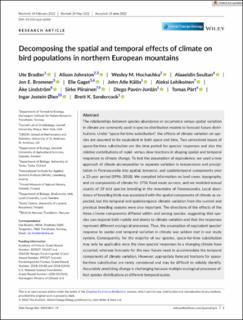Decomposing the spatial and temporal effects of climate on bird populations in northern European mountains
Bradter, Ute; Johnston, Alison; Hochachka, Wesley M.; Soultan, Alaaeldin; Brommer, Jon E.; Gaget, Elie; Kålås, John Atle; Lehikoinen, Aleksi; Lindström, Åke; Piirainen, Sirke; Pavòn-Jordàn, Diego; Pärt, Tomas; Øien, Ingar Jostein; Sandercock, Brett
Peer reviewed, Journal article
Published version
Permanent lenke
https://hdl.handle.net/11250/3014096Utgivelsesdato
2022Metadata
Vis full innførselSamlinger
- Publikasjoner fra CRIStin - NINA [2397]
- Scientific publications [1423]
Originalversjon
10.1111/gcb.16355Sammendrag
The relationships between species abundance or occurrence versus spatial variation in climate are commonly used in species distribution models (SDMs) to forecast future distributions. Under “space-for-time-substitution”, the effects of climate variation on species are assumed to be equivalent in both space and time. Two unresolved issues of space-for-time-substitution are the time period for species’ responses and also the relative contributions of rapid- versus slow re actions i n shaping spatial and temporal responses to climate change. To test the assumption of equivalence, we used a new approach of climatedecomposition to separate variationin temperature and precipitation i n Fennoscandi a into spatial, temporal and spatio-temporal components over a 23-year period (1996-2018). We compiled information on land cover, topography and six components of climate for 1756 fixed routesurveys and we modelled annual counts of 39 bird species breeding in the mountai nsof Fennoscandia. Local abundance of breeding birds was associated with the spatial components of climate as expected, but the temporal and spatio-temporal climatic variation from the current and previous breeding seasons were also important. The directions of the effects of the three climate components differed within and among species, suggesting that species can respond both rapidly and slowly to climate variation and that the responses represent different ecological processes. Thus, t he assumption of equivalent species’ response to spatial and temporal variation in climate was seldom met in our study system. C onsequently, for the majority of our species, space-for-time substitution may only be applicable once the slow species’ responses to a changi ng climate have occurred. Whereas forecasts for the near future need to accommodate the temporal components of climate variation. However, appropriate forecast horizons for space-for-time substitution are rarely considered and may be difficult to reliably identify. Accurately predicti ng change is challenging because multiple ecological processes affect species distributions at different temporal scales. Anticipatory forecasts, climate decomposition, dynamic forecasts, forecast hori zon, space-for-time substitution, spatio-temporal forecasting, spatio-temporal pattern,species distribution models, static forecasts

